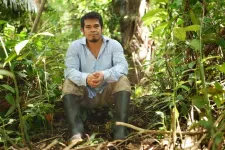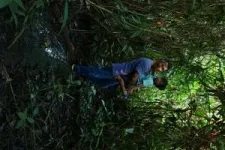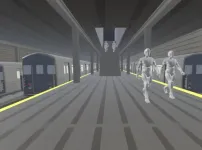(Press-News.org) Complex organisms, thousands of times smaller than a grain of sand, can shape massive ecosystems and influence the fate of Earth's climate, according to a new study.
Researchers from Arizona State University, along with their colleagues from the National University of the Peruvian Amazon, have identified an unknown family of microbes uniquely adapted to the waterlogged, low-oxygen conditions of tropical peatlands in Peru’s northwestern Amazonian rainforest.
The new research shows these microbes have a dual role in the carbon cycle and the potential to either moderate or intensify climate change. This process can either stabilize carbon for long-term storage or release it into the atmosphere as greenhouse gases, particularly CO2 and methane.
Under stable conditions, these microbes enable peatlands to act as vast carbon reservoirs, sequestering carbon and reducing climate risks. However, environmental shifts, including drought and warming, can trigger their activity, accelerating global climate change.
And, continued human-caused disruption of the natural peatland ecosystem could release 500 million tons of carbon by the end of the century — roughly equivalent to 5% of the world’s annual fossil fuel emissions.
"The microbial universe of the Amazon peatlands is vast in space and time, has been hidden by their remote locations, and has been severely under-studied in their local and global contributions, but thanks to local partnerships, we can now visit and study these key ecosystems,” says Hinsby Cadillo Quiroz, corresponding author of the new study and a researcher with the Biodesign Swette Center for Environmental Biotechnology at ASU.
“Our work is finding incredible organisms adapted to this environment, and several of them provide unique and important services — from carbon stabilization or recycling to carbon monoxide detoxification and others.”
Cadillo-Quiroz is also a researcher with the Biodesign Center for Fundamental and Applied Microbiomics and the ASU School of Life Sciences. ASU colleague Michael J. Pavia is the lead author of the investigation.
The study, appearing in the American Society for Microbiology journal Microbiology Spectrum, emphasizes the importance of protecting tropical peatlands to stabilize one of the planet’s most significant carbon storage systems and underscores the subtle interplay between microbial life and global climate regulation.
Why peatlands are crucial for climate stability
The Amazonian peatlands are among the planet’s largest carbon vaults, storing an estimated 3.1 billion tons of carbon in their dense, saturated soils — roughly twice the carbon stored in all the world’s forests. Peatlands are critical for global carbon storage because their waterlogged conditions slow decomposition, allowing organic material to accumulate over thousands of years. These ecosystems play a crucial role in regulating greenhouse gas emissions and influencing global climate patterns.
Building on earlier research, the current study describes newly identified microbes — part of the ancient Bathyarchaeia group that forms a complex network essential to the functioning of this ecosystem. The study highlights the remarkable abilities of these microorganisms to regulate carbon cycling in peatlands. Unlike most organisms, these microbes can thrive in extreme conditions, including environments with little to no oxygen, thanks to their metabolic flexibility.
The microbes are found in the Pastaza-Marañón Foreland Basin — a vital peatland in the northwestern Amazon rainforest of Peru. Encompassing approximately 100,000 square kilometers, the basin includes vast tracts of flooded rainforest and swamps underlain by ancient peat.
These peatland microbes consume carbon monoxide — metabolizing a gas toxic to many organisms — and convert it into energy, simultaneously reducing carbon toxicity in the environment. By breaking down carbon compounds, they produce hydrogen and CO2 that other microbes use to generate methane. Their ability to survive both oxygen-rich and oxygen-poor conditions makes them well suited to Amazonian environments, where water levels and oxygen availability fluctuate throughout the year.
However, shifts in rainfall, temperature and human activities, including deforestation and mining, are disrupting this delicate balance, causing peatlands to release greenhouse gases like carbon dioxide and methane.
Climate connection
While tropical peatlands currently act as carbon sinks, absorbing more carbon than they release, they are increasingly vulnerable to climate change. Rising temperatures and altered rainfall patterns could dry out these peatlands, turning them into carbon sources.
The release of billions of tons of carbon dioxide and methane from peatlands would significantly amplify global warming. The findings emphasize the urgent need to protect tropical peatlands from human activities and climate-induced stress.
The researchers advocate for sustainable land management, including reducing deforestation, drainage and mining activities in peatlands to prevent disruptions. Further investigation of microbial communities is needed to better understand their roles in carbon and nutrient cycling.
Tracking changes in temperature, rainfall and ecosystem dynamics is also necessary to predict future impacts on peatlands.
New directions
The discovery of highly adaptable peatland microbes advances our understanding of microbial diversity and underscores the resilience of life in extreme environments. These microbes represent a key piece of the puzzle in addressing global climate challenges, showing how the tiniest organisms can have an outsized impact on Earth's systems.
This research, supported by the National Science Foundation, marks a significant step forward in understanding the critical role of tropical peatlands and their microbial inhabitants in global carbon cycling. As climate change continues to reshape our planet, these hidden ecosystems hold lessons that may help safeguard our future.
Cadillo-Quiroz and his team plan to use this microbial and ecological knowledge for tropical peatlands management and restoration in their future work, which can be followed here.
“Working to understand microbes and ecosystems in the lush and magnificent Amazon rainforest is the honor of my life, which I aim to use in the protection of this region in the fight against climate change,” Cadillo-Quiroz says.
END
Scientists discover unique microbes in Amazonian peatlands that could influence climate change
Study underscores the urgent need to protect global tropical wetlands from human impact
2025-01-24
ELSE PRESS RELEASES FROM THIS DATE:
University Hospitals now offering ultra-minimally invasive endoscopic spine surgery for patients experiencing back pain
2025-01-24
CLEVELAND – University Hospitals is now offering endoscopic spine surgery for patients needing treatment for back pain due to herniated discs in their spine. Xiaofei (Sophie) Zhou, MD, completed Arthrex's Endoscopic Spine Training course to bring this advanced procedure to the health system and recently completed the first endoscopic discectomy utilizing Arthrex technology at UH. The health system is the only one in the greater Cleveland area offering this type of ultra-minimally invasive surgery.
Arthrex's technology allows surgeons to remove the ...
JNM publishes procedure standard/practice guideline for fibroblast activation protein PET
2025-01-24
Reston, VA (January 24, 2025)—The Society of Nuclear Medicine and Molecular Imaging (SNMMI) and the European Association of Nuclear Medicine (EANM) have issued a new procedure standard/practice guideline for the use of fibroblast activation protein (FAP) PET. Published in the January issue of The Journal of Nuclear Medicine, the procedure standard/practice guideline was developed to assist providers in recommending and performing FAP PET, as well as interpreting and reporting results of the imaging studies.
FAP is a transmembrane protein expressed on both cancer-associated fibroblasts and on normal activated fibroblasts involved in wound healing and ...
What to do with aging solar panels?
2025-01-24
The National Science Foundation Convergence Accelerator Program has granted $5 million dollars to Phase 2 of the project “Securing critical material supply chains by enabling phOtovoltaic circuLARity (SOLAR).”
SOLAR’s goal is to proactively ensure circularity of solar panels by providing solutions to barriers throughout the end-to-end supply chain. The intent is to make solar panels recyclable and find a solution to remanufacturing them at a competitive cost. Achieving this will help promote a clean and resilient energy system in the United States.
The three-year project is led by Battelle Memorial Institute ...
Scientists design peptides to enhance drug efficacy
2025-01-24
NEW YORK, NY, January 24, 2025 — A team of scientists has developed a groundbreaking approach using specially designed peptides to improve drug formulations. This innovative method significantly enhances anti-tumor efficacy, as demonstrated in leukemia models. The study, published in the journal Chem, was led by researchers at the Advanced Science Research Center at the CUNY Graduate Center (CUNY ASRC) and Memorial Sloan Kettering Cancer Center.
Drug delivery systems often face two critical challenges: poor solubility and inefficient delivery within the body. Many drugs do not dissolve well, making it difficult for them to reach ...
Collaboration to develop sorghum hybrids to reduce synthetic fertilizer use and farmer costs
2025-01-24
ST. LOUIS, MO, January 24, 2025 - A new collaborative research team of leading plant scientists are developing sorghums with nitrogen-saving traits by utilizing the genetic diversity of wild relatives to improve resilience and productivity for grain sorghum producers.
The project is part of a $38 million investment in nine projects by the U.S. Department of Energy, DOE, Advanced Research Projects Agency-Energy, ARPA-E, to develop advanced technologies for plants to increase nitrogen-use efficiency and reduce nitrogen pollution from U.S. bioenergy feedstocks.
Veena Veena, PhD, MBA, principal investigator and director of the Plant Transformation ...
Light-activated ink developed to remotely control cardiac tissue to repair the heart
2025-01-24
Researchers from Mass General Brigham and collaborating institutions have developed a non-invasive approach to manipulate cardiac tissue activity by using light to stimulate an innovative ink incorporated into bioprinted tissue. Their goal is to develop a technique that can be used to repair the heart. Their findings in preclinical models, published in Science Advances, show the transformative potential of non-invasive therapeutic methods to control electrically active tissues.
“We showed for the first time that with this optoelectronically active ink, we can print scaffolds that allow remote control of engineered heart tissues,” said co-corresponding ...
EMBARGOED: Dana-Farber investigators pinpoint keys to cell therapy response for leukemia
2025-01-24
Boston – Dana-Farber Cancer Institute researchers have identified factors that determine whether donor lymphocyte infusion (DLI), a standard therapy for patients with acute myeloid leukemia (AML) who have relapsed after allogenic hematopoietic stem cell transplant, will successfully move the patient into remission. The team identified that a key cell type in the DLI product and features of the tumor microenvironment in patients both play a role.
The findings were published in Science Immunology.
“Relapse of AML after stem cell transplant is a major challenge,” says first author Katie ...
Surgeon preference factors into survival outcomes analyses for multi- and single-arterial bypass grafting
2025-01-24
LOS ANGELES—January 24, 2025—In patients undergoing coronary artery bypass grafting (CABG), a novel analysis evaluating surgeon preference for multi- versus single-arterial grafting may help explain the differing results between prior retrospective analyses and randomized controlled trials regarding long-term survival.
A study presented this week at The Society of Thoracic Surgeons’ 61st Annual Meeting explores findings in more than a million U.S. Medicare beneficiaries who underwent CABG from 2001 to 2019. The researchers found that patients who received multi-arterial grafting (MAG) had improved survival over those who ...
Study points to South America – not Mexico – as birthplace of Irish potato famine pathogen
2025-01-24
Call it a mystery solved.
North Carolina State University researchers firmly point the finger at the South American Andes Mountains as the place where the Irish potato famine pathogen, Phtytophthora infestans, originated.
In a wide-ranging study of the genetic material found in P. infestans and other members of the Phytophthora species, the NC State researchers provide more evidence that P. infestans spread from South America to North America before wreaking havoc in Ireland in the 1840s. The pathogen still causes late-blight disease on potato and tomato plants around the world.
Much ...
VR subway experiment highlights role of sound in disrupting balance for people with inner ear disorder
2025-01-24
The vestibular system is a network of organs in the inner ears that detects the motions and position of the head. The brain uses this information, along with inputs from the eyes and joints, to maintain the body’s balance.
Visual information has long been proven to affect balance—for example, strobe lights and swirling images can cause instability—but a new study published in PLOS ONE shows that sounds can also be a disruptive factor for those who have vestibular hypofunction, a vestibular system disorder resulting in impaired balance.
“People with vestibular hypofunction have ...
LAST 30 PRESS RELEASES:
New modeling approach sheds light on rare gut disease
Study documents potentially hazardous flame retardants in firefighter gear
Can certain bacteria regulate aging of the immune system and its related alterations?
AI model helps diagnose often undetected heart disease from simple EKG
There are fewer online trolls than people think
Cell membrane fluctuations produce electricity
Jeonbuk National University study shows positive parenting can protect adolescents against self-harm
Surface-engineered ZnO nanocrystals to tackle perfluoroalkyl substance contamination
This new understanding of T cell receptors may improve cancer immunotherapies
A new fossil face sheds light on early migrations of ancient human ancestor
A new immunotherapy approach could work for many types of cancer
A new way to diagnose deadly lung infections and save lives
40 percent of MRI signals do not correspond to actual brain activity
How brain-inspired algorithms could drive down AI energy costs
Gum disease may be linked to plaque buildup in arteries, higher risk of major CVD events
Contrails are a major driver of aviation’s climate impact
Structure of dopamine-releasing neurons relates to the type of circuits they form for smell-processing
Reducing social isolation protects the brain in later life
Keeping the heart healthy increases longevity even after cancer
Young adults commonly mix cannabis with nicotine and tobacco
Comprehensive review illuminates tau protein's dual nature in brain health, disease, and emerging psychiatric connections
Book prepares K-12 leaders for the next public health crisis
Storms in the Southern Ocean mitigates global warming
Seals on the move: Research reveals key data for offshore development and international ecology
Sports injuries sustained during your period might be more severe
World's first successful 2 Tbit/s free-space optical communication using small optical terminals mountable on satellites and HAPS
Can intimate relationships affect your heart? New study says ‘yes’
Scalable and healable gradient textiles for multi‑scenario radiative cooling via bicomponent blow spinning
Research shows informed traders never let a good climate crisis go to waste
Intelligent XGBoost framework enhances asphalt pavement skid resistance assessment
[Press-News.org] Scientists discover unique microbes in Amazonian peatlands that could influence climate changeStudy underscores the urgent need to protect global tropical wetlands from human impact







